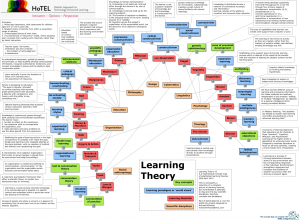If you’ve ever wanted a single source for the major theories related to learning, check out Richard Millwood’s hypertextual concept map for the Holistic Approach to Technology Enhanced Learning (HoTEL). Wow, this will give you a lot to dig into – especially if you’re new to curriculum development and instructional design or need to refresh and revitalize your existing course-development approach. Even with all the recent advancements in learning technologies, the theories that created our fundamental building blocks for good course development are still relevant today.

David Kolb and Benjamin Bloom’s theories are two that I often dive into when I need to get back to basics. I’ve found their insight into understanding the types of learners and the classifications of learning objectives have created a practical foundation that helps me develop successful learning solutions. With corporate training primarily focused on improving workforce performance, understanding learning styles and role-based objectives is crucial to an effective learning program.
As more learning organizations adopt strategies like gamification and xAPIs, it’s easy to get distracted by the entertainment and data-capture capabilities. By combining the advancements in technology-enabled learning with proven theories, however, we can expand on those initial ideas and find new ways to improve training development.
You’ll discover in Millwood’s concept map that Kolb and Bloom are just two of the theorists who have shaped the learning world. I only mentioned them in this blog because of their relevance to workforce performance training. Depending on your audience and learning strategy, there’s likely a theory that helps you understand the “why” and a method to show you “how”.
Over the next few blogs, I’ll share a few insights into how we apply Kolb and Bloom’s theories to improve our clients’ learning experiences. I’ll also explore methods, such as Kirkpatrick’s levels of learning evaluation and Phillips’ ROI method, that help us gauge our learning outcomes.







